Cummins opens first Master Rebuild Centre in Europe
04 October 2023
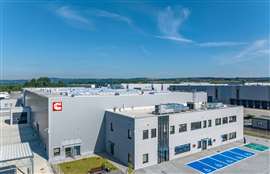 Cummins’ European Master Rebuild Centre in Krakow (Photo: Cummins)
Cummins’ European Master Rebuild Centre in Krakow (Photo: Cummins)
Cummins has held the opening of its new high horsepower Master Rebuild Centre (MRC) in Krakow, Poland. The location will primarily complete work on larger engines with displacements of between 19 and 78 litres and power outputs ranging from 450 to 3500 horsepower. This includes the Cummins QSK19, QSK38 and QSK60 engines.
In a press briefing held at the new centre, Ann-Kristin de Verdier, executive managing director for Cummins’ Europe Distribution Business said: “Cummins has been manufacturing diesel engines for over 100 years, and while we would always be happy to supply customers with a new engine, if there is a way to keep an existing engine working to peak performance then that should be the first option. That’s why we have built this new centre.”
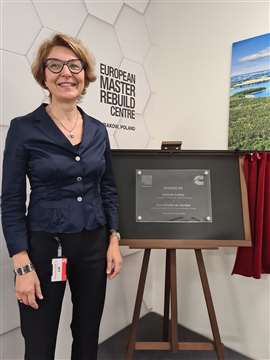 Ann-Kristin de Verdier, with plaque commemorating the opening of the new MRC
Ann-Kristin de Verdier, with plaque commemorating the opening of the new MRC
Representing an investment of $10 million (approx. €9.5 million), the 4,600 square metre facility is the first of its kind in Europe. It joins a network of 14 other MRC sites around the world. Rebuilt engines generally come from customers in the mining and marine sectors, although the process is not limited to those business areas.
Asked why it had taken this long for Cummins to open an MRC in Europe, Ignacio Gonzalez, executive director, Power Systems, Europe and Global Industrial Power, said: “Europe is not a big mining location. [An MRC] needs a good base of high horsepower engines to make it worthwhile.” He continued: “But localisation and the push by companies to reduce their carbon footprint has opened up the market.”
Cummins executives noted that they expect mining operations in Europe to increase as imports of raw materials from Russia have been banned due to the war in Ukraine. These operations will largely be centred in Nordic countries, where copper and precious metals are mined for a variety of industries.
Factory environment
According to material published by Cummins, more than 30 sites were put forward as a location for the new MRC, but ultimately Krakow was awarded the new plant. Located in southern Poland, the city offers ease of access to both Eastern and Western Europe via major highway routes, plus Krakow airport is nearby.
The new facility will rebuild and test engines to the highest quality standards in an environment intended to emulate that of a factory production floor. Benefits of selecting an engine rebuild over a new engine include a shorter lead time; the goal is to achieve a turnaround time of 35 days from engine arrival to shipping the rebuilt engine back to the customer. The process offers customers upfront savings of between 10 and 20% over a new, first-fit engine of identical specification, helping to improve total cost of ownership and overall sustainability.
Where available, a like-for-like engine swap could be considered, which would virtually eliminate any turnaround time.
MRC sites offer three rebuild and remanufacture options: Classic Refresh; Advanced Rebuild; and Ultimate. The Krakow facility will offer the Advanced Rebuild and Ultimate, as these are considered of more value to regional customers.
Chris Brown, Aftermarket Development and Channel Management director for Europe said that engines undergoing the Ultimate rebuild will come with the same warranties and life expectancy of a new engine. “The engines undergo a vigorous inspection,” he explained. “They are rebuilt using Cummins original parts and then undergo a full range of tests, including performance validation, dynamometer testing and oil analysis.”
Brown explained that the rebuild process consists of six individual steps: Disassembly; Cleaning; Inspection; Components; Assembly; and Testing. After these are completed the engines are painted in the customer’s choice of colour.
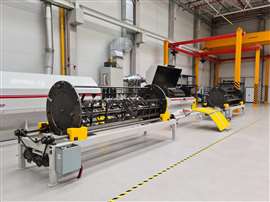 Part cleaning process uses water up to 350C
Part cleaning process uses water up to 350C
“The first four steps are the most important,” said Brown. “In an Ultimate refit, the Disassembly process starts with a total teardown of the engine. Cleaning involves a thermal bake and blast cleaning to remove any dirt or swarf. Then each part goes through the Inspection process using non-destructive testing, then we certify which parts require replacing in the Components stage.”
He emphasised that every step is completed as if the engine is being manufactured and assembled as new. “The [remanufactured] engines are expected to last up to 28,000 hours. There can’t be any mistakes.”
Sustainability counts
The remanufacturing process as a whole supports related sustainability efforts by extending engine operation into a second or even third lifetime. But the individual engine remanufacturing stages also feature sustainable processes.
Engines are first blasted and cleaned in the wash bay. But unlike most systems, the water is recycled within a closed loop. Held in a 600-litre tank, the water includes additives and biocides to stop any microbial growth and maintain water quality.
Individual engine components are then mounted on part-specific jigs in preparation for a thermal cleaning process. No acids or corrosive liquids are used, while the machines further feature a decarbonising afterburner to recycle waste material. The blast facility can bring metal parts back to an as-new state.
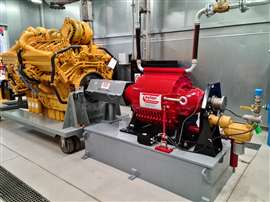 Dynomometer uses a water-actuated engine braking system
Dynomometer uses a water-actuated engine braking system
Following the remanufacturing process, all engines are run on the dynamometer, to check pressures and power output. The dyno test cell is said to use less fuel than other systems, while coolant is recycled in another closed-loop system. To increase the accuracy of the test, the dyno can be configured to emulate the duty cycle of the engine, such as a mining haul truck.
In his comments at the press event, Marek Matuszewski, Country Leader, Poland, the Baltic States and Ukraine, noted: “The site uses 85% less energy than a new engine facility. To help improve that, we’re planning to use green energy, including energy generated here onsite.”
Customer support
Cummins offers a series of customer support options to help improve total cost of ownership and the overall user experience.
The PrevenTech digital monitoring system can recognise faults or performance issues to help increase engine availability and performance. In addition, for engines which do not feature onboard telematics there is an upgrade package of sensors which can be fitted during the remanufacturing process. These support monitoring of performance levels, with collected data sent to a remote monitor for final review.
Another benefit of the rebuild programme is an option to include the Eliminator self-cleaning filtration system. This removes acids from the engine oil, helping to extend service intervals. Speaking about the Eliminator system, Brown noted: “Fuel and oil are the largest expenditures when running an engine. If you can extend the life of the engine oil and filters, the customer can save a lot of cash.”
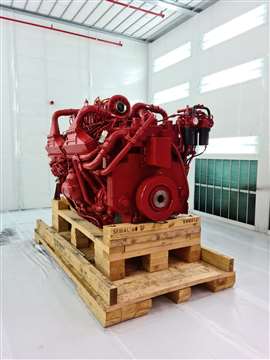 Paint booth has various filters to remove particles from air
Paint booth has various filters to remove particles from air
In addition, the QuickFit system is also available. When an oil change is required, this helps to complete the service in about 30 minutes.
Brown added: “After ‘how much will the engine cost?’, the next question customers ask is ‘How will you support me?’ Support for rebuilds, including these features, is the same as it would be for a new engine.”
Future forward
Engine rebuilds can take anywhere between 120 and 500 hours. This translates to about 100 engines being refitted each year, based on a single-shift rota.
In addition to diesel engine remanufacturing, many of the models undergoing the rebuild process are compatible with E20 diesel (which uses 20% biodiesel) and hydrotreated vegetable oil (HVO). While a well-maintained diesel engine is already highly fuel efficient, this will help to further decarbonise the engines.
The MRC is an interesting addition to the Cummins business portfolio in Europe, both in terms of customer service and improved sustainability. But it is further expected that the new site will help support new engine sales, in that it will help reduce total cost of ownership across an engine’s lifetime.
Brown: “It’s vitally important to be selected as a supplier in the first place. That has to happen before an engine can be used across its first, second and third life.”
STAY CONNECTED




Receive the information you need when you need it through our world-leading magazines, newsletters and daily briefings.
POWER SOURCING GUIDE
The trusted reference and buyer’s guide for 83 years
The original “desktop search engine,” guiding nearly 10,000 users in more than 90 countries it is the primary reference for specifications and details on all the components that go into engine systems.
Visit Now
CONNECT WITH THE TEAM










